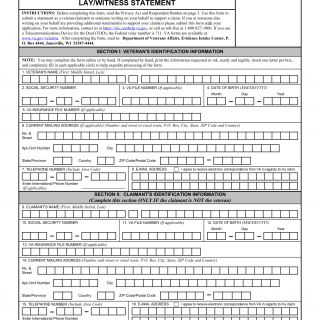VA Form 21-10210. Lay/Witness Statement
The VA Form 21-10210 Lay/Witness Statement is an important document used by veterans or individuals who can provide relevant information or testimony to support a veteran's claim for benefits from the Department of Veterans Affairs (VA). The main purpose of this form is to gather statements from laypersons or witnesses who have firsthand knowledge of the veteran's condition, events, or circumstances related to their claim.
This form consists of several parts that must be completed accurately and thoroughly. It starts with the veteran's personal information, including their name, contact details, and the claimant's relationship to the veteran. The form then provides sections for the layperson or witness to provide their own personal information, including their name, contact details, and their relationship to the veteran.
The important fields in this form include a section where the layperson or witness can provide a detailed statement regarding their knowledge of the veteran's condition or circumstances. They are encouraged to provide specific details, dates, and any other relevant information that can support the veteran's claim. Additionally, the form includes a section where the witness can indicate if they are willing to testify at a hearing or provide further information if needed.
When filling out the form, it is crucial to provide accurate and truthful information. The statements provided by laypersons or witnesses can significantly impact the outcome of a veteran's claim. It is important to be as detailed and specific as possible, providing any relevant facts, events, or observations that can support the veteran's case. It is also essential to attach any additional documents or evidence that can corroborate the information provided in the statement.
The VA Form 21-10210 Lay/Witness Statement is particularly useful in cases where a veteran's condition or circumstances may not be fully documented in official records or medical documents. Laypersons or witnesses who have personal knowledge of the veteran's situation can provide valuable firsthand accounts that can strengthen the veteran's claim for benefits.
Strengths of this form include its ability to gather testimonies and statements from individuals who have direct knowledge of the veteran's condition or circumstances. These statements can provide a unique perspective and add credibility to the veteran's claim. Additionally, the form provides a clear structure for laypersons or witnesses to provide their statements, ensuring that all relevant information is captured.
However, there are also potential weaknesses and challenges associated with the VA Form 21-10210. One challenge is ensuring the accuracy and reliability of the information provided by laypersons or witnesses. The VA may evaluate the credibility of the statements and consider factors such as the witness's relationship to the veteran and their ability to provide accurate and unbiased information.
There are several related and alternative forms that may be encountered in the claims process. One example is the VA Form 21-4138 Statement in Support of Claim, which allows veterans or their representatives to provide additional information and evidence to support their claim. While the VA Form 21-4138 is a general statement form, the VA Form 21-10210 specifically focuses on gathering statements from laypersons or witnesses.
The VA Form 21-10210 Lay/Witness Statement can significantly impact the future of the participants by providing crucial evidence and testimony to support the veteran's claim. A well-prepared and detailed statement from a layperson or witness can strengthen the veteran's case and potentially increase their chances of receiving the benefits they deserve.
The completed form can be submitted through various channels, including mail, fax, or online submission through the VA's eBenefits portal. It is important to follow the instructions provided by the VA reg
arding submission methods and deadlines to ensure that the form is received and processed in a timely manner.
Once submitted, the form is typically stored in the veteran's claims file maintained by the VA. This file contains all the relevant documents and forms related to the veteran's claim and is used by the VA to assess and make decisions on the claim.

